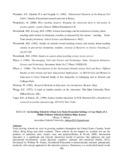An Inviting School in Urban Low Socio-Economic Setting: A Case Study of A Public Primary School In Kibera Slum, Kenya
Abstract
Truly inviting schools do exist in growing numbers throughout the United States, Canada, South
Africa, Hong Kong and other countries. These schools do not happen by accident but are the
products of optimism, trust, respect, care, and purpose(Purkey & Novak, 2008). Invitational
education is a significant and relevant theoretical model of practice that addresses the total
educational environment: social, physical, cognitive, spiritual, and emotional (Smith, 2011).
Developed by William W. Purkey, Invitational Education is democratically oriented, perceptually
anchored, self-concept approach to the educative process. Democracy is a social ideal based on the conviction that all people matter and can grow through participation in self-governance (Purkey &
Novak, 2008). According to Purkey & Novak, 2008, people who are affected by decisions should
have a say in formulating those decisions. This model postulates that each person creates their own
reality through their perceptions of what they believe to be real (Combs, Richards and Richards,
1998; Combs & Gonzales, 1994; Kelly, 1995, 1963; Jourard, 1971 cited in Smith, 2011). The
perceptual tradition maintains that all human behavior is a product of how people see themselves
and the situations in which they are involved (Purkey & Novak, 2008). Human energy and
motivation are always there but the role and responsibility of educators is to influence the direction
this intrinsic energy and motivation will take. Human motivation is always there and it is a force
that comes from within each person. However, this motivation is determined by how an individual
see himself or herself-self-concept. Smith (2011) argued that a person’s self-concept can change
and develop as a result of inviting or encouraging acts. In this paper, I present findings on the five
aspects -5Ps as perceived by pupils and teachers of a public primary school in an urban low socioeconomic
setting in Nairobi,Kenya.
Collections
- Master of Education [29]

